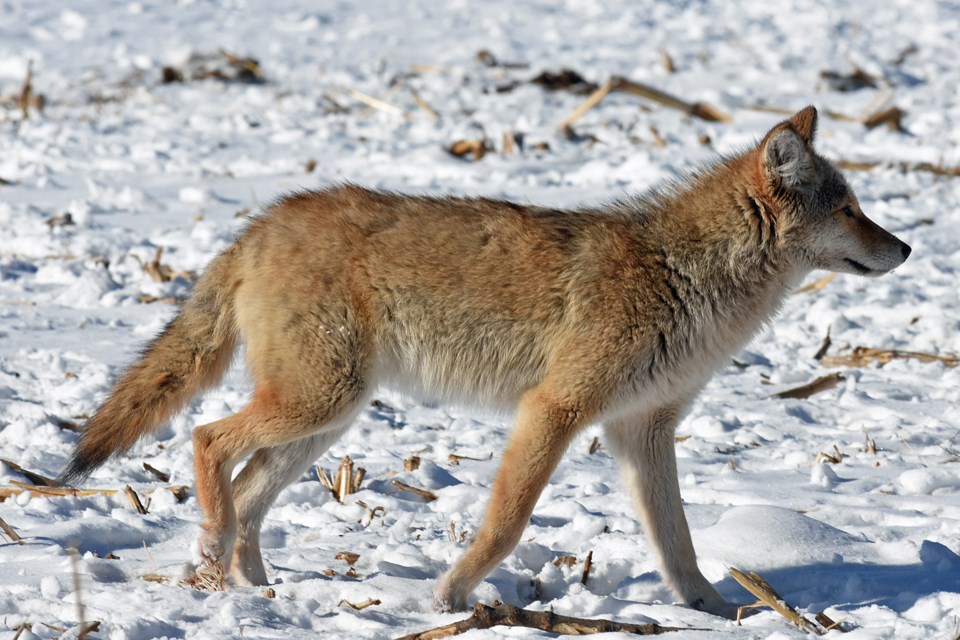The stitched pattern of tracks that wandered across our windswept back field indicated the start of a seasonal event ... coyote mating season. The recent magnificent full moon that we enjoyed viewing has been labelled, quite fittingly, the Wolf Moon.
Coyotes are common in this area, surviving everywhere from isolated woodlots to high use recreational areas to urban residential sites. They are a very adaptable critter and have successfully survived centuries of both unwarranted persecution and unprecedented habitat loss.
The coyotes that live in Simcoe County are a mix of pure-bred and hybrid animals; as settlements of farms with free roaming dogs changed the construct of southern Ontario, these ‘mixed marriages’ became fairly common. Some think the introduction of domesticated dog genes watered down the wild genes and the offspring became less frightened of interacting with humans.
There are biologists today who feel quite strongly that a pure-blood coyote no longer exists, that all we encounter today are of hybrid lineage.
Traditionally, mating season for coyotes runs late January to early March and lone males will wander far and wide in search of females. The red fox is similar, and when fox rabies was rampant in the 1950s and 60s, infected male foxes could inflict damage over several kilometres a night. Thankfully, coyotes rarely contract rabies (and fox rabies has all but been eliminated in Ontario).
Coyotes feed heavily on meadow voles, and the track pattern I observed showed where the coyote had stepped aside to pounce into the thick snow, hoping to pin down a burrowing vole. This hunting technique is quite successful and does not get the respect it deserves, as we tend to “oohh and aww” at an owl’s ability to hear into the snow ... coyotes are just as adept!
The other main dietary compliments for a coyote are apples and, if very lucky, cottontail rabbits. The re-introduction of wild turkeys to southern Ontario in the 1980s has also added to the coyote’s opportunity to find nutritious food in the winter months.
Over the many centuries of human-coyote interactions, there are a few incidents when sheep or very young calves have been predated upon. Note the key word ‘few’. Yes, livestock predation has and does occur, but in very low numbers of incidents. A study of the situation usually results in the culprit being a desperate female with a family of starving pups.
A number of years ago I spoke with a sheep farmer out Elmvale way who had been losing sheep to coyotes. He mentioned that several neighbours had offered to conduct a wide-spread coyote hunt to rid the area of the predators. The shepherd declined their offer and instead requested the services of a good marksman to shoot only the animals that were conducting these raids.
The strategy worked, and the surviving coyotes that did not have a taste for lamb continued to hunt the fields for the numerous crop-eating meadow voles and cottontail rabbits.
Coyotes do not hunt like wolves. Coyotes do not gang up on deer to wreak havoc in a winter deer yard.
They hunt as individuals or as a pair, hoping to scare a rabbit back and forth until one of them can close in and catch it. But should a deer be weakened by poor health, or more likely had been clipped by a car, the coyotes will indeed take full advantage of this free meal.
It takes a lot on energy and a lot of bulk for a predator to take down a healthy deer, energy and body weight the coyote does not possess. Every ‘deer kill’ that I have investigated revealed broken leg bones, the result of a vehicle collision. But, wow, the efficiency in which the deer carcass was cleaned up over the course of two or three nights was amazing ... nothing left expect the rumen (deer’s stomach).
In addition to the coyote’s skill at finding food during the lean winter months, they also have other interesting adaptations. One is their fur, which consists of a thick layer of underfur and long guard hairs, which are hollow. Hollow hairs (which deer also have) are insulative and buoyant.
Back in the 1970s I bought a winter parka with a coyote fur-lined hood. Despite my sweating and exhaustive breath, the fur never caked with frost, a trait noticed and utilized by even the land’s earliest human inhabitants. Those hollow hairs acted as an efficient guard against the damp cold air. Coats of today, with their false fur, do not come close to this natural fabric.
That set of tracks in our field continued its lonely course towards the west, towards the vast Copeland Forest.
To the east of us is a good-sized cedar swamp, and I know a coyote family has occupied this area for many years. Perhaps we’ll hear the yelps and howls of another generation this coming spring; I hope so.
